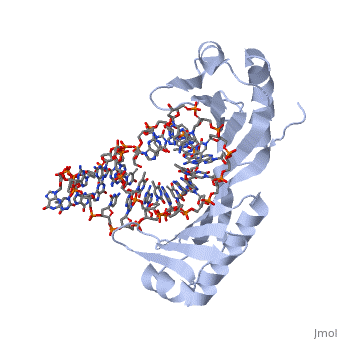TATA-Binding Protein
From Proteopedia
(→Acknowledgements) |
|||
| Line 26: | Line 26: | ||
== Acknowledgements == | == Acknowledgements == | ||
| - | *Content adapted from David S. Goodsell Molecule of the Month on the TATA-Binding Protein [http://mgl.scripps.edu/people/goodsell/pdb/pdb67 Molecule of the Month] | + | *Content adapted with permission from David S. Goodsell Molecule of the Month on the TATA-Binding Protein [http://mgl.scripps.edu/people/goodsell/pdb/pdb67 Molecule of the Month] |
Revision as of 09:25, 30 April 2008
|
The enzyme RNA polymerase performs the delicate task of unwinding the two strands of DNA and transcribing the genetic information into a strand of RNA. But how does it know where to start? Our cells contain 30,000 genes encoded in billions of nucleotides. For each gene, the cell must be able to start transcription at the right place and at the right time. The TATA-binding protein helps in the process of recruiting the enzyme RNA polymerase by first recognizing and binding to a characteristic sequence of nucleotides, called the to represent its thymine-adenine-thymine-adenine nucleotide motif, in front of the start site of transcription.
Contents |
Getting Started
Specialized DNA sequences next to genes, called promoters, define the proper start site and direction for transcription. Promoters vary in sequence and location from organism to organism. In bacteria, typical promoters contain two regions that interact with the sigma subunit of their RNA polymerase. The sigma subunit binds to these DNA sequences, assists the start of transcription, and then detaches from the polymerase as it continues transcription through the gene. Our cells have a far more complex promoter system, using dozens of different proteins to ensure that the proper RNA polymerase is targeted to each gene. The TATA-binding protein is the central element of this system.
The TATA Box
Our protein-coding genes have a characteristic sequence of nucleotides, termed the TATA box, in front of the start site of transcription. The typical sequence is something like T-A-T-A-a/t-A-a/t, where a/t refers to positions that can be either A or T. Surprisingly many variations on this theme also work, and one of the challenges in the study of transcription is discovering why some sequences work and others don't. The TATA-binding protein (sometimes referred to as TBP) recognizes this TATA sequence and binds to it, creating a landmark that marks the start site of transcription. When the first structures of TATA-binding protein were determined, researchers discovered that TATA-binding protein is not gentle when it binds to DNA. Instead, it grabs the TATA sequence and bends it sharply, as seen in 1ytb, 1tgh and 1cdw.
Helpers
TATA-binding protein works as part of a larger transcription factor, TFIID, that starts the process of transcription. After it binds to the promoter, it recruits additional transcription factors. TFIIB, shown at the top here 1vol, binds next. Then a string of other transcription factors bind, constructing a large protein complex that decides whether or not to start transcription. These may include transcription activators, such as TFIIA shown in the middle 1ytf, that promote the start of transcription. Other factors inhibit the start of transcription, such as the transcription regulator NC2 (negative cofactor 2), shown at the bottom 1jfi. In all of these pictures, TATA-binding protein is shown in blue, a small piece of DNA is shown in red and the transcription factor is shown in green.
Exploring the Structure
|
TATA-binding protein uses two types of interactions to recognize and hold the TATA sequence, as seen in this structure 1ytb. First, it has a string of lysine and arginine amino acids that interact with the . This glues the to the . Second, the protein uses specially-placed amino acids to interact with DNA bases. jam into the DNA minor groove and form the kinks that bend the DNA. There are also that form hydrogen bonds at the very center. The combination of the unusual flexibility of TATA DNA sequences and these specific hydrogen bonds allows TATA-binding protein to recognize the proper sequence.
As you are looking at these structures yourself, notice that TATA-binding protein, even though it is composed of a single protein chain, is . This symmetry is easily seen in the two pairs of phenylalanines and the two asparagines. It is thought that an ancient gene duplication created this protein by combining two copies of the same gene.
Acknowledgements
- Content adapted with permission from David S. Goodsell Molecule of the Month on the TATA-Binding Protein Molecule of the Month
Proteopedia Page Contributors and Editors (what is this?)
Ala Jelani, Michal Harel, Eran Hodis, Alexander Berchansky, David Canner

